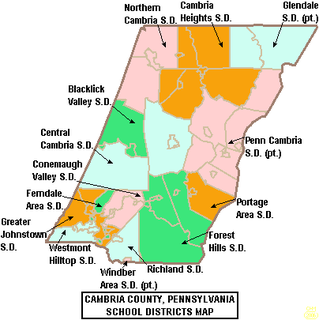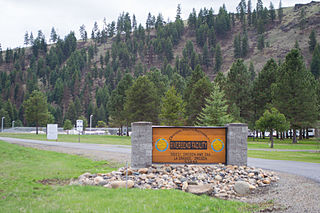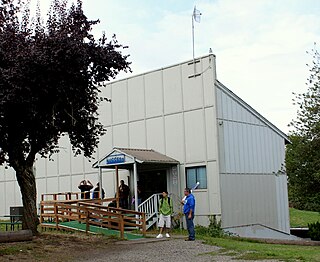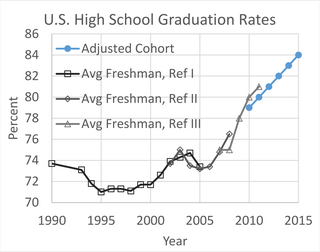Related Research Articles

America's Promise Alliance is the nation’s largest cross-sector alliance of nonprofit, community organizations, businesses, and government organization dedicated to improving the lives of young people.
Dropping out means leaving high school, college, university or another group for practical reasons, necessities, or disillusionment with the system from which the individual in question leaves.
An exit examination is a test that students must pass to receive a diploma and graduate from school. Such examinations have been used in a variety of countries; this article focuses on their use within the United States. These are usually criterion-referenced tests which were implemented as part of a comprehensive standards-based education reform program which sets into place new standards intended to increase the learning of all students.

Richland High School is a small, rural public high school located at One Academic Avenue, Johnstown, Pennsylvania. In 2014, Richland High School enrollment was reported as 788 pupils in 7th through 12th grades, with 22.6% of pupils eligible for a free lunch due to family poverty. Additionally, 8.6% of pupils received special education services, while 2% of pupils were identified as gifted. The school employed 43 teachers. Per the Pennsylvania Department of Education, 2% of the teachers were rated "Non‐Highly Qualified" under the federal No Child Left Behind Act. The school is not a Title I school. Richland High School is the sole high school operated by Richland School District.

Roberts High School is a high school located in Salem, Oregon, United States. It provides non-traditional educational programs in the Salem-Keizer School District. Rather than a centralized campus, Roberts High School consists of departments at different sites in Salem and Keizer. These branch sites include the Downtown Learning Center, Structured Learning Center, Bridge, and Internet-based SK Online. In the 2006-2007 school year, over 1,000 students were enrolled in Roberts High School.

Minneapolis Public Schools (MPS) or Special School District Number 1 is a public school district serving students in pre-kindergarten through twelfth grade from Minneapolis, Minnesota. Minneapolis Public Schools enroll 36,370 students in public primary and secondary schools. The district administers about one hundred public schools including forty-five elementary schools, seven middle schools, seven high schools, eight special education schools, eight alternative schools, nineteen contract alternative schools and five charter schools. With authority granted by the state legislature, the school board makes policy, selects the superintendent, and oversees the district's budget, curriculum, personnel, and facilities. Students speak ninety different languages at home and most school communications are printed in English, Hmong, Spanish, and Somali.

Lower Dauphin High School is a midsized, suburban, public high school located in Hummelstown, Pennsylvania. It is part of the Lower Dauphin School District, serving Hummelstown, East Hanover, South Hanover, Londonderry Township, and Conewago Township. In 2013, enrollment was reported as 1,176 pupils in 9th through 12th grades, with 13% of pupils eligible for a free lunch due to the family meeting the federal poverty level. Additionally, 15% of pupils received special education services, while 5.9% of pupils were identified as gifted. The school employed 69 teachers. Per the PA Department of Education 100% of the teachers were rated "Highly Qualified" under the federal No Child Left Behind Act. The school is not a federally designated Title I school.

Forest Grove High School is a public high school in Forest Grove, Oregon, United States. Founded in 1907, it is the only high school in the Forest Grove School District.
The Communities In Schools (CIS) is an American non-profit organization that works within public and charter schools to help at-risk students to stay in school and perform well
Eastern Lebanon County High School, referred to as ELCO High School, is located in Myerstown, Pennsylvania. It is a four-year high school with a total student enrollment of 810.

James Buchanan High School is a small, rural public high school. The School is located in Mercersburg, Pennsylvania and is part of the Tuscarora School District. James Buchanan High School was named after the 15th president of the United States, James Buchanan. In 2013, enrollment was reported as 785 pupils in 9th through 12th grades, with 27% of pupils eligible for a free lunch due to family poverty. Additionally, 15% of pupils received special education services, while 1% of pupils were identified as gifted. The school employed 48 teachers. Per the PA Department of Education 100% of the teachers were rated "Highly Qualified" under the federal No Child Left Behind Act.
Albany Options School is a public alternative school in Albany, Oregon, United States. It provides alternative education for students who are working below or above state benchmark standards. These opportunities include transitional programs, credit-recovery programs, higher-education courses and education through contracted services. Albany Options School is an accredited alternative school serving middle school, high school and GED students. The school also had a preschool program linked with the Boys & Girls Club of Albany at the Albany Options School, serving up to 20 children close to the age of 5.

RiverBend Alternative Education School, also known as Riverbend Youth Accountability Camp and RiverBend High School, is an alternative high school in La Grande, Oregon, United States. It is located at a juvenile correctional facility operated by the Oregon Youth Authority.
William P. Lord High School is a public high school in Woodburn, Oregon, United States. It is named after William Paine Lord, the Governor of Oregon from 1895 to 1899. It is located at the MacLaren Youth Correctional Facility, and operates a vocational tech program.

Woodburn Success Alternative High School, also known as Woodburn Success School, is a public alternative high school in Woodburn, Oregon, United States.
Race to the Top, abbreviated R2T, RTTT or RTT, was a $4.35 billion United States Department of Education competitive grant created to spur and reward innovation and reforms in state and local district K–12 education. Funded as part of the American Recovery and Reinvestment Act of 2009, it was announced by President Barack Obama and Secretary of Education Arne Duncan on July 24, 2009. States competing for the grants were awarded points for enacting certain educational policies, instituting performance-based evaluations for teachers and principals based on multiple measures of educator effectiveness, adopting common standards, adopting policies that did not prohibit the expansion of high-quality charter schools, turning around the lowest-performing schools, and building and using data systems.
Simon Youth Foundation (SYF) is a non-profit, 501 (c)(3) organization that supports efforts in the United States to improve the national academic dropout rate and increase college accessibility by partnering with established public school systems. The foundation's parent company is the Simon Property Group. Although SYF works closely with Simon Property Group, it is not a corporate or grant-making foundation. SYF is headquartered in Indianapolis, Indiana. Its current CEO is J. Michael Durnil, Ph.D.

The graduation completion rate is the measure reflecting the number of students who complete their graduation and receive a degree from an educational institution. The drop-out rate is the measure reflecting the number of students who disengage with the educational institutions they are enrolled in. Those measures are calculated by the National Center for Education Statistics (NCES), the primary federal U.S. entity for collecting and analyzing data related to education.

The United States Department of Education's measurement of the status dropout rate is the percentage of 16 to 24-year-olds who are not enrolled in school and have not earned a high school credential. This rate is different from the event dropout rate and related measures of the status completion and average freshman completion rates. The status high school dropout rate in 2009 was 8.1%. There are many risk factors for high school dropouts. These can be categorized into social and academic risk factors. Whites and members of racial and ethnic minority groups drop out at higher rates than Asian-American students, as do those from low-income families, from single-parent households, mentally disabled students, and from families in which one or both parents also did not complete high school. Students at risk for dropout based on academic risk factors are those who often have a history of absenteeism and grade retention, academic trouble, and more general disengagement from school life. High school dropouts in the U.S. are more likely to be unemployed, have low-paying jobs, be incarcerated, have children at early ages and/or become single parents. There is not a single race in the United States that as of 2019, has a 90 percent graduation rate. In order to achieve this rate by 2020, we would need to graduate almost 200,000 more students in time.

The Dropout Prevention Act – also known as: Title I, Part H, of No Child Left Behind - is responsible for establishing the school dropout prevention program under No Child Left Behind. This part of No Child Left Behind was created to provide schools with support for retention of all students and prevention of dropouts from the most at-risk youth. It is estimated that 1.2 million American students drop out of high school each year. The US Department of Education assesses the dropout rate by calculating the percentage of 16- to 24-year-olds who are not currently enrolled in school and who have not yet earned a high school credential. For example, the high school dropout rate of the United States in 2008 was 8.1%.
References
- ↑ Diploma Plus (2009) "The Diploma Plus Paths to Success Archived 2010-05-01 at the Wayback Machine ". Accessed October 2010
- ↑ Steiny, Julia; "Diploma Plus approach specializes in educating dropouts", The Providence Journal, February 14, 2010. Accessed October 2010
- ↑ Hess, Frederick; "The Transformative Promise of "Greenfield" Schooling Removing Barriers to Innovation Is the First Step in Creating an Environment in Which Innovation Can Flourish", American Enterprise Institute for Public Policy Research. February 1, 2010. Accessed October 2010
- ↑ "School Networks Receive Grant to Strengthen Efforts to Prepare Students for College and Career Success", Bill and Melinda Gates Foundation, March 26, 2009. Accessed Oct 2010
- ↑ "Barack Obama and Joe Biden's Plan for Lifetime Success Through Education Archived 2010-12-06 at the Wayback Machine " (2009). Accessed October 2010
- ↑ Brand, Betsy; Hooker, Sarah; (October 2009) "How 23 Programs Support Youth on the Path to College and Beyond Archived 2010-10-12 at the Wayback Machine " American Youth Policy Forum. Accessed Oct 2010
- ↑ "Model Programs Database: Middle/Early College", National Dropout Prevention Center/Network. Accessed Oct 2010
- ↑ Princiotta, Daniel and Ryan Reyna. (2009) "Achieving Graduation for All A Governor’s Guide to Dropout Prevention and Recovery", National Governor's Association Center for Best Practices. Accessed Oct 2010
- ↑ Ballard, Gregory A., Cory Booker and Karl Dean. "An Education Stimulus for the Nation's Cities", Education Week. October 21, 2009. Accessed Oct 2010